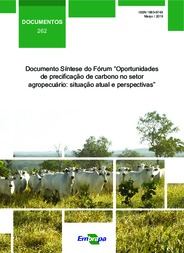New Low Carbon Brazilian Beef (LCBB) protocol allowed 4.34 animal units (AU) per hectare as opposed to 1.93 AU/ha in conventional management.. Even with more animals, the LCBB area showed slightly higher weight gain: 154 kg per head in one year, compared to 149 kg in the conventional management area. Higher density also allowed higher yield per area: there was a growth of 163% in dressed weight produced per hectare. Performance has been attributed to good farming practices such as the fertilization of pastures, strategic supplementation, maintenance of the appropriate management level and of pasture land cover at always above 80% of the area. Protocol shows important land-saving effect: by producing more in the same area, it reduces the need for new pastures With suitable management of the livestock production system, it is possible to have 125% more animals per hectare and a dressed weight/ha 163% higher than conventional management. All of that ensures the final product's quality, carbon fixation in the soil and control of methane emissions. The data are part of the first protocol for low carbon emission meat production in Brazil, the Low Carbon Brazilian Beef (LCBB) one. Embrapa obtained that data in a beef cattle farming Technological Reference Unit (URT, from the acronym in Portuguese), located in Bahia's Cerrado, through carbon stock, cattle weight gain, meat quality and methane emission assessments. According to Embrapa Southern Livestock researcher Márcia Silveira, who coordinates protocol validation, the LCBB concept brand intends to value cattle farming systems that do not have the forest component, but that have the potential to mitigate greenhouse gas emissions (GHGs) through adequate pasture management and the adoption of good agricultural practices. Embrapa and Marfrig Global Foods have made a strategic partnership to enhance the value added to Brazilian beef, which involves the concept brands Low Carbon Brazilian Beef (LCBB) and Carbon Neutral Brazilian Beef (CNBB). “The study intended to assess the production of beef cattle in systems with well-managed pastures to validate guidelines in a commercial setting. The initial results show that, by implementing LCBB guidelines, it is possible to guarantee productivity and meat quality in order to increase farmer profitability. All that, without giving up the maintenance or increase of soil carbon stocks and the mitigation of GHGs emissions, in addition to the land-saving effect related to the system's productivity gains, which make it possible to increase meat production with less pressure on native vegetation. It is another step toward productive efficiency that considers the quality of the product and its production environment,” the scientist states. The technical guidelines for Low Carbon Brazilian Beef production, assessed in this research, involve compliance with appropriate pasture management practices, such as height monitoring, stocking rate adjustments, adequate fertilization to the demand of forage plants and the level of intensification of the system, as well as the adoption of Good Agricultural Practices (GAPs). Platform gathers technologies to reduce emissions The protocol is part of the Low Carbon Livestock Platform (PBC, in Portuguese), an Embrapa initiative to contribute to the strategies of the Low Carbon Agriculture Plan (ABC+) facing the challenges of climate change scenarios. The research is part of the Trijunção Project, which began in December 2017, and which is coordinated by researcher Flávia Santos, from Embrapa Maize and Sorghum (Sete Lagoas, MG). The PBC Platform, a network project led by researcher Roberto Giolo, from Embrapa Beef Cattle (Campo Grande, MS), intends to develop certification mechanisms for some beef cattle products produced in livestock systems focused on low carbon emissions, based on concept brands, such as Carbon Neutral Calf (CNC), Low Carbon Brazilian Beef (LCBB), Native Carbon (NC) and Carbon Neutral Leather (CN Leather), as well as a carbon calculator (C calc). "The benefits go to the farmer, to the beef chain as a whole, and to Brazil, as it promotes a greater appreciation of the product and better visibility for the country in the global market," Giolo analyzes, while stating that the initiative also contributes to minimize the pressure to clear new areas for cattle raising, because it has a land-saving effect and, therefore, helps in the efforts to equate the issue of deforestation in Brazil. Methane emissions Emission intensity did not vary between managements, with an average value of 6.3 kg of CO2-equivalent per kilogram of carcass. "LCBB management allowed an increase of 125% in the number of animals per hectare and of 163% in dressed weight for the same area in comparison with conventional management. That indicates an important land-saving effect, in addition to the potential for greater carbon sequestration in the soil to maintain the pasture's productive condition and mitigate the system's greenhouse gas emissions,” researcher Roberto Giolo says. The research The case study began in May 2019 at Santa Luzia Ranch, which belongs to the Trijunção Farm, located in Jaborandi, Bahia. This farm is a reference in beef cattle production through Good Agricultural Practices (GAPs), with structured and sequential data of the entire production system. The URT was composed of two plots, as well as an area of native vegetation (Cerrado). The first plot with the forage grass Brachiaria brizantha cv. Marandu has 115 hectares divided into four pickets, representing conventional management. The second plot, of a pasture restored with Brachiaria brizantha cv. BRS Piatã, has 85 hectares, and is also divided into four pickets, but it is managed according to the technical guidelines for low-carbon meat production in tropical pastures (LCBB). The areas were used for rebreeding and finishing males of the Nelore breed. The data from the initial categorization (ground zero) of the soil for LCBB management showed a stock of 20.59 t ha-1 (ton per hectare) of carbon in the 0-20 cm layer of the soil. The value is higher than that found in native Cerrado (15.18 t ha-1) and in pastures under conventional management (18.16 t ha-1). “Since these values were obtained in an initial categorization, assessments with two-year intervals will be made to follow the evolution of these areas’ stocked carbon. However, it is already possible to realize that soil carbon stock in LCBB management is above the others,” explain the researchers responsible for the space, Flávia Santos and Manoel Ricardo Filho, from Embrapa Maize and Sorghum. With the maintenance of the recommended pasture height for the cultivated forage, the plot with LCBB management allowed average loads of 4.34 animal units (AU) per hectare against 1.93 AU/ha in the plot under conventional management, as well as land coverage always above 80%. That ever-high soil cover on the LCBB plot contributes with straw to the soil's organic matter and carbon retention in the system. Throughout the first year of assessment, animals from the LCBB and conventional management plots gained on average 154 kg and 149 kg per pasture, respectively. "Therefore, in addition to the higher number of AU per hectare, the animals of the LCBB plot entered the feedlot heavier and reached slaughter weight at least 20 feedlot days earlier than the animals of the conventional management plot,” Márcia highlights. “With pasture fertilization, strategic supplementation, and correct management, it was possible to guarantee a high production of body weight per unit of area in the LCBB plot, and the yield values recorded are above the average of Brazilian yield. As for the plot under conventional management, although the average daily gain was not much different from the LCBB plot, we observed a gain per area below the potential,” the Embrapa Southern Livestock researcher says. Beef quality In the assessment of carcass and beef quality of LCBB animals, average slaughter and dressed weights of 573 kg and 306 kg, respectively, were recorded, providing an average carcass yield of 53.4%, with 100% of the carcasses presenting type-3 finishing (medium fat) and two-teeth maturity. For beef quality analysis, it was observed that the average marbling score was 7.7, i.e. the average marbling was of the small type. The mean shear force was 6.3 kg, ranging from 4.87 to 8.17 kg. "While no animal had meat that was considered tough (>9 kg), almost two out of three animals had meat under 7 kg, which could be considered as acceptably tender meat if evaluated by a panel of trained tasters. Thus, the beef quality, marbling, and shear strength observed are compatible with the existing production systems in Brazil and meet the market's demands,” says the Embrapa Beef Cattle researcher responsible for the data, Gelson Feijó.
Photo: Dalizia Aguiar
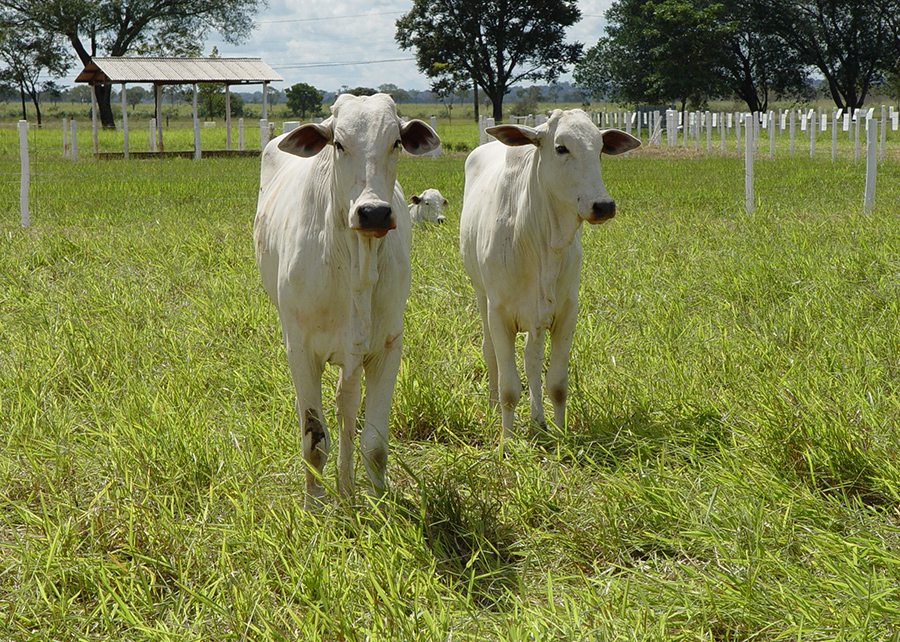
The LCBB concept brand values cattle systems that do not have the forestry component but have the potential to mitigate greenhouse gas (GHG) emissions.
-
New Low Carbon Brazilian Beef (LCBB) protocol allowed 4.34 animal units (AU) per hectare as opposed to 1.93 AU/ha in conventional management.. -
Even with more animals, the LCBB area showed slightly higher weight gain: 154 kg per head in one year, compared to 149 kg in the conventional management area. -
Higher density also allowed higher yield per area: there was a growth of 163% in dressed weight produced per hectare. -
Performance has been attributed to good farming practices such as the fertilization of pastures, strategic supplementation, maintenance of the appropriate management level and of pasture land cover at always above 80% of the area. -
Protocol shows important land-saving effect: by producing more in the same area, it reduces the need for new pastures |
With suitable management of the livestock production system, it is possible to have 125% more animals per hectare and a dressed weight/ha 163% higher than conventional management. All of that ensures the final product's quality, carbon fixation in the soil and control of methane emissions. The data are part of the first protocol for low carbon emission meat production in Brazil, the Low Carbon Brazilian Beef (LCBB) one. Embrapa obtained that data in a beef cattle farming Technological Reference Unit (URT, from the acronym in Portuguese), located in Bahia's Cerrado, through carbon stock, cattle weight gain, meat quality and methane emission assessments.
According to Embrapa Southern Livestock researcher Márcia Silveira, who coordinates protocol validation, the LCBB concept brand intends to value cattle farming systems that do not have the forest component, but that have the potential to mitigate greenhouse gas emissions (GHGs) through adequate pasture management and the adoption of good agricultural practices. Embrapa and Marfrig Global Foods have made a strategic partnership to enhance the value added to Brazilian beef, which involves the concept brands Low Carbon Brazilian Beef (LCBB) and Carbon Neutral Brazilian Beef (CNBB).
“The study intended to assess the production of beef cattle in systems with well-managed pastures to validate guidelines in a commercial setting. The initial results show that, by implementing LCBB guidelines, it is possible to guarantee productivity and meat quality in order to increase farmer profitability. All that, without giving up the maintenance or increase of soil carbon stocks and the mitigation of GHGs emissions, in addition to the land-saving effect related to the system's productivity gains, which make it possible to increase meat production with less pressure on native vegetation. It is another step toward productive efficiency that considers the quality of the product and its production environment,” the scientist states.
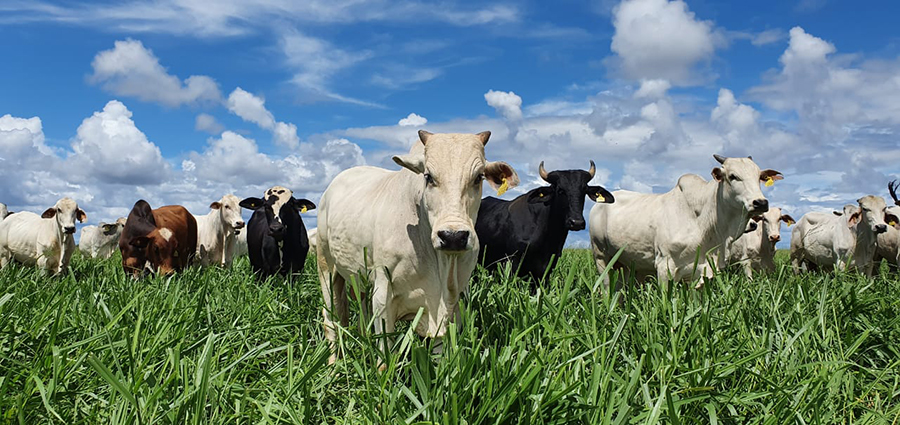 The technical guidelines for Low Carbon Brazilian Beef production, assessed in this research, involve compliance with appropriate pasture management practices, such as height monitoring, stocking rate adjustments, adequate fertilization to the demand of forage plants and the level of intensification of the system, as well as the adoption of Good Agricultural Practices (GAPs).
The technical guidelines for Low Carbon Brazilian Beef production, assessed in this research, involve compliance with appropriate pasture management practices, such as height monitoring, stocking rate adjustments, adequate fertilization to the demand of forage plants and the level of intensification of the system, as well as the adoption of Good Agricultural Practices (GAPs).
Platform gathers technologies to reduce emissions The protocol is part of the Low Carbon Livestock Platform (PBC, in Portuguese), an Embrapa initiative to contribute to the strategies of the Low Carbon Agriculture Plan (ABC+) facing the challenges of climate change scenarios. The research is part of the Trijunção Project, which began in December 2017, and which is coordinated by researcher Flávia Santos, from Embrapa Maize and Sorghum (Sete Lagoas, MG). The PBC Platform, a network project led by researcher Roberto Giolo, from Embrapa Beef Cattle (Campo Grande, MS), intends to develop certification mechanisms for some beef cattle products produced in livestock systems focused on low carbon emissions, based on concept brands, such as Carbon Neutral Calf (CNC), Low Carbon Brazilian Beef (LCBB), Native Carbon (NC) and Carbon Neutral Leather (CN Leather), as well as a carbon calculator (C calc). "The benefits go to the farmer, to the beef chain as a whole, and to Brazil, as it promotes a greater appreciation of the product and better visibility for the country in the global market," Giolo analyzes, while stating that the initiative also contributes to minimize the pressure to clear new areas for cattle raising, because it has a land-saving effect and, therefore, helps in the efforts to equate the issue of deforestation in Brazil. |
Methane emissions
Emission intensity did not vary between managements, with an average value of 6.3 kg of CO2-equivalent per kilogram of carcass. "LCBB management allowed an increase of 125% in the number of animals per hectare and of 163% in dressed weight for the same area in comparison with conventional management. That indicates an important land-saving effect, in addition to the potential for greater carbon sequestration in the soil to maintain the pasture's productive condition and mitigate the system's greenhouse gas emissions,” researcher Roberto Giolo says.
 The research
The research
The case study began in May 2019 at Santa Luzia Ranch, which belongs to the Trijunção Farm, located in Jaborandi, Bahia. This farm is a reference in beef cattle production through Good Agricultural Practices (GAPs), with structured and sequential data of the entire production system. The URT was composed of two plots, as well as an area of native vegetation (Cerrado). The first plot with the forage grass Brachiaria brizantha cv. Marandu has 115 hectares divided into four pickets, representing conventional management. The second plot, of a pasture restored with Brachiaria brizantha cv. BRS Piatã, has 85 hectares, and is also divided into four pickets, but it is managed according to the technical guidelines for low-carbon meat production in tropical pastures (LCBB). The areas were used for rebreeding and finishing males of the Nelore breed.
The data from the initial categorization (ground zero) of the soil for LCBB management showed a stock of 20.59 t ha-1 (ton per hectare) of carbon in the 0-20 cm layer of the soil. The value is higher than that found in native Cerrado (15.18 t ha-1) and in pastures under conventional management (18.16 t ha-1). “Since these values were obtained in an initial categorization, assessments with two-year intervals will be made to follow the evolution of these areas’ stocked carbon. However, it is already possible to realize that soil carbon stock in LCBB management is above the others,” explain the researchers responsible for the space, Flávia Santos and Manoel Ricardo Filho, from Embrapa Maize and Sorghum.
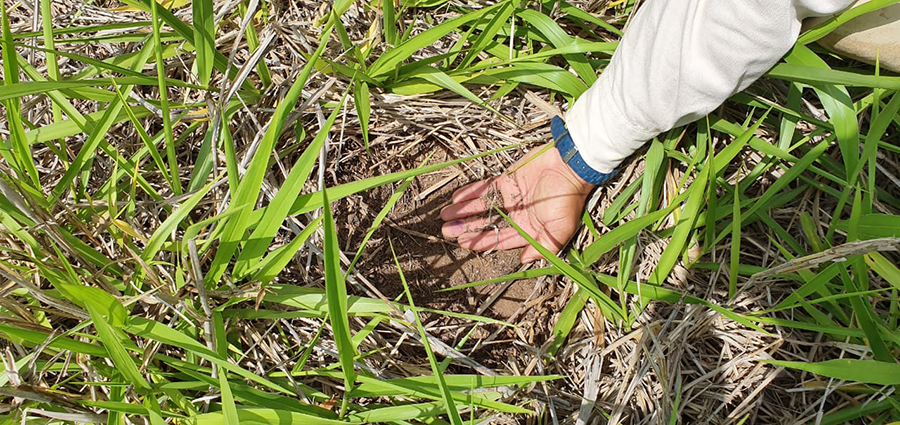 With the maintenance of the recommended pasture height for the cultivated forage, the plot with LCBB management allowed average loads of 4.34 animal units (AU) per hectare against 1.93 AU/ha in the plot under conventional management, as well as land coverage always above 80%. That ever-high soil cover on the LCBB plot contributes with straw to the soil's organic matter and carbon retention in the system. Throughout the first year of assessment, animals from the LCBB and conventional management plots gained on average 154 kg and 149 kg per pasture, respectively. "Therefore, in addition to the higher number of AU per hectare, the animals of the LCBB plot entered the feedlot heavier and reached slaughter weight at least 20 feedlot days earlier than the animals of the conventional management plot,” Márcia highlights.
With the maintenance of the recommended pasture height for the cultivated forage, the plot with LCBB management allowed average loads of 4.34 animal units (AU) per hectare against 1.93 AU/ha in the plot under conventional management, as well as land coverage always above 80%. That ever-high soil cover on the LCBB plot contributes with straw to the soil's organic matter and carbon retention in the system. Throughout the first year of assessment, animals from the LCBB and conventional management plots gained on average 154 kg and 149 kg per pasture, respectively. "Therefore, in addition to the higher number of AU per hectare, the animals of the LCBB plot entered the feedlot heavier and reached slaughter weight at least 20 feedlot days earlier than the animals of the conventional management plot,” Márcia highlights.
“With pasture fertilization, strategic supplementation, and correct management, it was possible to guarantee a high production of body weight per unit of area in the LCBB plot, and the yield values recorded are above the average of Brazilian yield. As for the plot under conventional management, although the average daily gain was not much different from the LCBB plot, we observed a gain per area below the potential,” the Embrapa Southern Livestock researcher says.
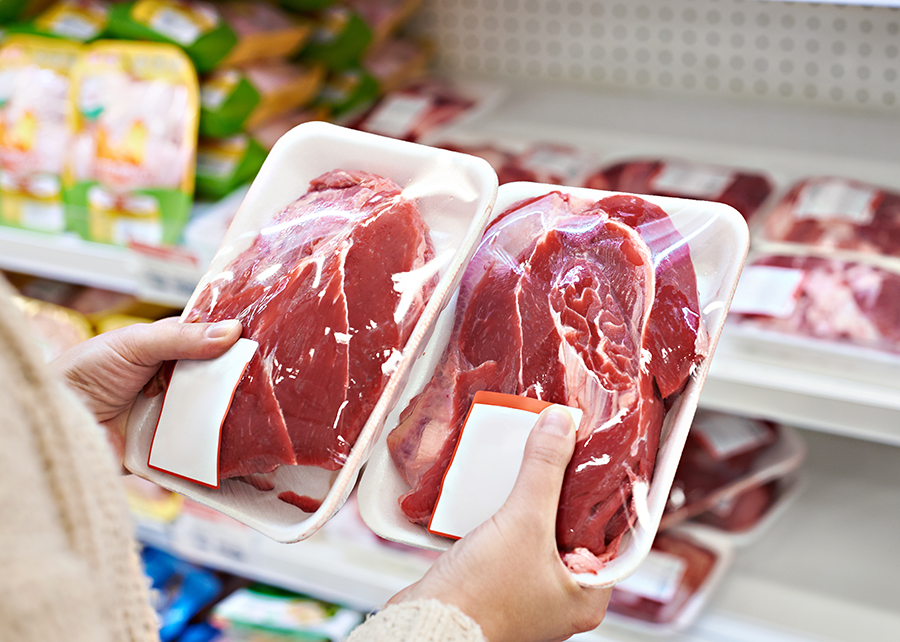 Beef quality
Beef quality
In the assessment of carcass and beef quality of LCBB animals, average slaughter and dressed weights of 573 kg and 306 kg, respectively, were recorded, providing an average carcass yield of 53.4%, with 100% of the carcasses presenting type-3 finishing (medium fat) and two-teeth maturity. For beef quality analysis, it was observed that the average marbling score was 7.7, i.e. the average marbling was of the small type. The mean shear force was 6.3 kg, ranging from 4.87 to 8.17 kg. "While no animal had meat that was considered tough (>9 kg), almost two out of three animals had meat under 7 kg, which could be considered as acceptably tender meat if evaluated by a panel of trained tasters. Thus, the beef quality, marbling, and shear strength observed are compatible with the existing production systems in Brazil and meet the market's demands,” says the Embrapa Beef Cattle researcher responsible for the data, Gelson Feijó.
Felipe Rosa (MTb 14406/RS)
Embrapa Southern Livestock
Press inquiries
pecuária-sul.imprensa@embrapa.br
Phone number: +55 53 99933-8526
Dalízia Aguiar (MTb 28/03/14/MS)
Embrapa Beef Cattle
Press inquiries
gado-de-corte.imprensa@embrapa.br
Phone number: +55 67 99942-3787
José Heitor Vasconcellos (MTb 12914/RJ)
Embrapa Maize and Sorghum
Press inquiries
milho-e-sorgo.imprensa@embrapa.br
Translation: Raquel Porlan, supervised by Mariana Medeiros (13044/DF)
General Secretariat
Further information on the topic
Citizen Attention Service (SAC)
www.embrapa.br/contact-us/sac/

The technical guidelines for Low Carbon Brazilian Beef production, assessed in this research, involve compliance with appropriate pasture management practices, such as height monitoring, stocking rate adjustments, adequate fertilization to the demand of forage plants and the level of intensification of the system, as well as the adoption of Good Agricultural Practices (GAPs).
 The research
The researchWith the maintenance of the recommended pasture height for the cultivated forage, the plot with LCBB management allowed average loads of 4.34 animal units (AU) per hectare against 1.93 AU/ha in the plot under conventional management, as well as land coverage always above 80%. That ever-high soil cover on the LCBB plot contributes with straw to the soil's organic matter and carbon retention in the system. Throughout the first year of assessment, animals from the LCBB and conventional management plots gained on average 154 kg and 149 kg per pasture, respectively. "Therefore, in addition to the higher number of AU per hectare, the animals of the LCBB plot entered the feedlot heavier and reached slaughter weight at least 20 feedlot days earlier than the animals of the conventional management plot,” Márcia highlights.
 Beef quality
Beef quality

